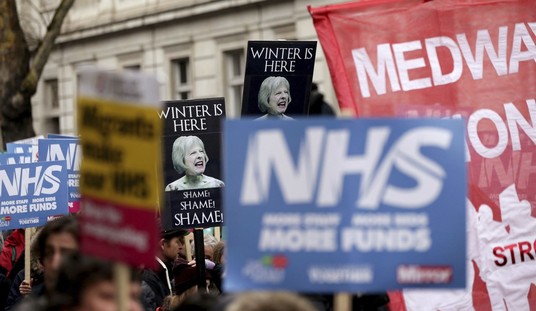At least we all seem to agree on one point — ObamaCare is a disaster. What to do about it is another matter, as the New York Times reports after its acknowledgment that ObamaCare’s structural flaws are not merely growing pains, as the White House wants to claim. Democrats — and the NYT analysis — lean toward increasing government intervention into a market that got broken by … government intervention:
The fierce struggle to enact and carry out the Affordable Care Act was supposed to put an end to 75 years of fighting for a health care system to insure all Americans. Instead, the law’s troubles could make it just a way station on the road to another, more stable health care system, the shape of which could be determined on Election Day.
Seeing a lack of competition in many of the health law’s online insurance marketplaces, Hillary Clinton, President Obama and much of theDemocratic Party are calling for more government, not less.
One might take the lesson from the initial government intervention that perhaps a bunch of lawmakers and bureaucrats in Washington don’t know how to run risk pools. The NYT’s own report passively offers the evidence:
“Employer markets are fairly stable, but the individual insurance market does not feel stable at all,” said Janet S. Trautwein, the chief executive of the National Association of Health Underwriters, which represents more than 100,000 agents and brokers who specialize in health insurance. “In many states, the individual market is in a shambles.”
Did the federal government take over the employer-based health insurance market? Nope. That’s why that market has remained (relatively) stable, while the market that the central planners arrogated to themselves has turned into a shambles. The basic problem in this market is government intervention, and it has unfolded precisely how critics of that intervention predicted from the very beginning. The coverage and purchase mandates, especially the demand that everyone buy comprehensive-care insurance that millions of Americans don’t really need, has touched off a death spiral in the individual market that has insurers running for the exits.
The solution? The hair of the dog:
For their part, many Democrats are clamoring for a public insurance option, as they did nine years ago.
“Supporters of the public option warned that private insurance companies could not be trusted to provide reliable coverage or control costs,” said Richard J. Kirsch, who led a grass-roots organization that fought for passage of the Affordable Care Act in 2009 and 2010. “The shrinking number of health insurers is proof that these warnings were spot on.”
That’s utter nonsense. The public option existed in the original plan for one reason only — to use the government’s monopoly power to force insurers out of the markets. The argument behind it was that Greedy Insurers sucked the lifeblood out of sick Americans, and that only price competition from a Medicare-esque option would keep prices low. If that was true, then we wouldn’t see insurers bailing out of the markets after premiums have doubled and deductibles have skyrocketed out of sight. Insurers have lost money for the last few years, and only the promise of government bailouts keeps those remaining from taking flight as well.
Besides, we did have a stand-in for the public options in the ObamaCare co-ops. How did they do at providing “reliable coverage” that “control[s] costs”? They collapsed under a tidal wave of red ink, and Congress’ prevention of using general funds for bailing them out. All a public option would do is transfer ever-higher costs to taxpayers, and hide them in the federal budget.
As I noted in a special column for The Fiscal Times over the weekend, HHS is breaking the law already on its use of funds without the public option:
Republicans in Congress found out that HHS didn’t competently calculate the insurer contributions to the program – and decided to keep all of the money instead. They demanded an investigation by the GAO, which confirmed that HHS had violated the law by keeping the funds without Congressional authorization. That amounts to $5 billion that HHS took from the general fund, and kept without specific Congressional appropriation.
GAO makes it clear that the Treasury contributions had to be kept separate from fund disbursements. The statute clearly states that the portions designated for the general fund “shall be deposited into the general fund of the Treasury of the United States and may not be used for the program established under this section [emphasis mine.” The law could not possibly be clearer on this point.
Despite this clarity, GAO found that HHS used the money for the program anyway. “When total collections for benefit year 2014—$9.7 billion—fell short of the target amount for reinsurance payments, HHS did not allocate any collections to the Treasury or to administrative expenses,” GAO investigators reported.
“The agency received $7.9 billion in reinsurance claims and paid these in full, leaving approximately $1.7 billion in collections, which it carried over for reinsurance payments in subsequent benefit years. As a result, HHS did not deposit any amounts collected from issuers into the Treasury.”
In other words, HHS deliberately violated the law and stiffed taxpayers. Even worse, they banked the leftover cash rather than even attempting to comply with the statutory requirements of Obamacare.
HHS stole $5 billion from taxpayers over three years to stave off the death spiral. How much will they steal in a public option? Five billion dollars would be a drop in the bucket.
At least we’re all in agreement that ObamaCare is unsustainable. Clearly, the markets without government control do better, and the markets without third-party payers of any kind for non-catastrophic care (LASIK and cosmetic surgery) do best. Perhaps even Washington politicians can figure out what this means.








Join the conversation as a VIP Member